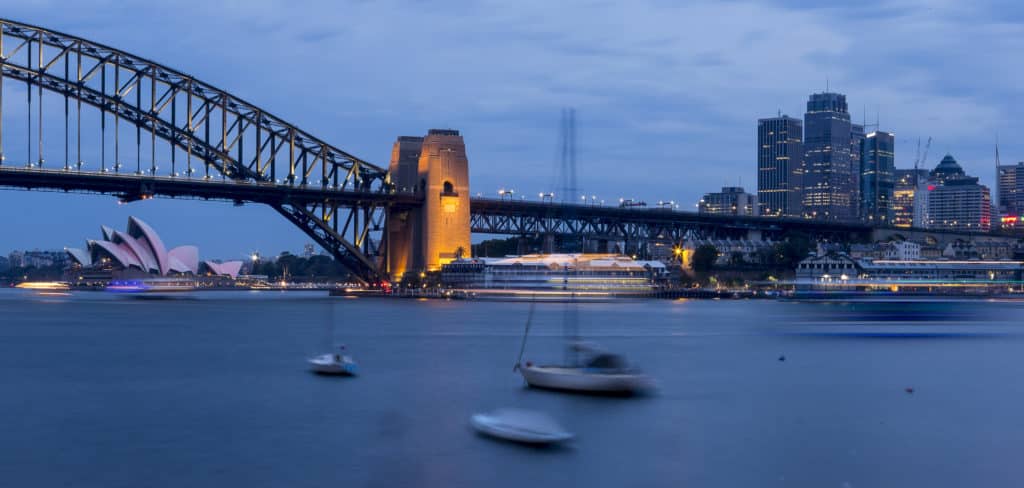
Sydney Harbor and Bridge at night.
Pelagic, our Crealock 37, drove down the very lowest reaches of the Clarence River, in New South Wales, Australia, with main and jib drawing. The ocean swell was reaching us, but Pelagic was still hemmed tight by the massive stone breakwaters on each side of the river — an odd place to be sailing our bluewater boat. Our son Elias, 2 years old and firmly strapped into his car seat under the dodger, felt none of the tension of the moment; young children go to sea without carrying their parents’ mental cargo of concern over what might go wrong. My wife, Alisa, and I did feel the nerves of leaving port. But we also felt the impending release.
We came to the moment of peak tension as we approached the entrance bar. The river bars of New South Wales can be nasty, and a prawn trawler had been rolled on this one just a few weeks before. But we had the leisure of picking the right tide on a perfect day, and we easily slid over the shallows and into deep water beyond.
The place we were leaving behind, the little beach town of Iluka, had found a special place in our hearts. It had given us a perfectly protected harbor, with coastal rainforest and miles of beach within easy walking distance. And it had offered us a group of like-minded Australians who, over an endless series of morning surf sessions and evening barbecues, could introduce us to the delights of being Australian.
This last part was particularly important. When we had finished the year-and-a-half sail from our home in Alaska and cleared into the port of Bundaberg, we’d known little of Australia. But we were newcomers with a difference. Elias and I cleared in on our brand-new Australian passports, obtained just for the trip, and Alisa on an Australian spouse visa. Although I had never lived in Australia, I’d had the good fortune to be born there. And so we’d had a mission when we left Alaska on Pelagic: to sail to Australia to discover this country that we were a part of.
At first our exploration of Oz had revealed soulless vacation towns, the kind of places we clearly hadn’t left Alaska to see. But then we found Iluka, and it was there that we began to see what our Australia might look like.
Our planned two-week visit to Iluka had blown out to four months. But now it was time to move again, and we wanted to use the cyclone-free season to sail north in the tropics to Townsville, where I was born. Yet as any traveling sailor knows, the goal of a cruise is less important than how you get there. Our real hope was that the slow travel and out-of-the-way places that are the hallmarks of coastal cruising would be an ideal way to discover more of the country.
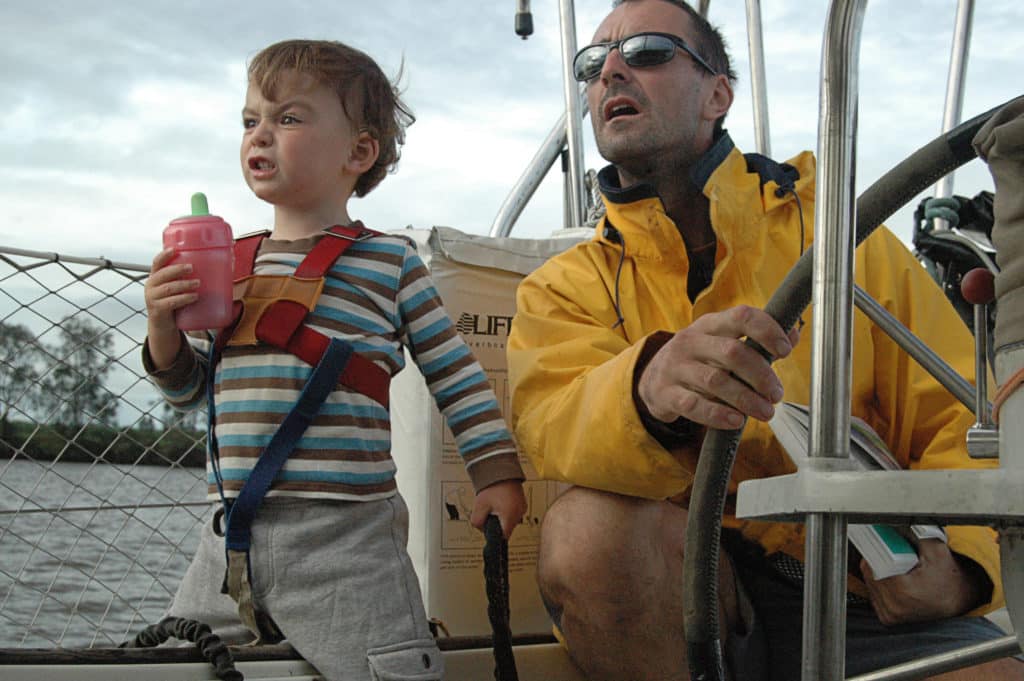
Elias woke me a little before dawn, calling out from his bunk, “I’m all done in here!” The family gathered in the cockpit for the sunrise, and we were reminded of the magic progression of dawn at sea. We watched the waves slowly change from leaden shapes to brilliant beaten metal as the light grew, and then we ate breakfast in the cockpit with the knowledge that we had ahead of us a whole day at sea to enjoy.
After just one night of sailing, Iluka seemed completely removed from us. We were falling back into the habits of being underway — habits that had been tough to learn during our first few months afloat, but which were now second nature after sailing across the Pacific.
When outsiders think of eastern Australia, they think of the Great Barrier Reef. But the reef isn’t part of the picture for sailors; it’s too far offshore, with few usable anchorages. Instead, the next few weeks found us exploring a low coastline of sandy straits and mud-bottomed creeks with eucalyptus-fringed anchorages where kookaburras cackled and parrots screamed. The little towns we passed had bucolic names — Seventeen Seventy, Yeppoon — and the anchorages had a restrained beauty. My 41st birthday caught us at Pancake Creek, a little tidal estuary surrounded by low sandy banks on one side and a high point, Bustard Head, on the other, complete with walking paths and a lighthouse to visit — our kind of place.
Alisa produced a cake for the event, of course, and when it came time to make a wish, I thought to myself, “There’s nothing else I want.”
Most foreign yachts had left Oz for the cyclone-free season in the tropics, so we were without the company of other voyaging sailors, a group of people who are always surprising us with sudden good friendship. We missed the state of belonging to some sort of community, even if it was the ever-so-loose community of vagabonding sailors. So it was good that we had a goal for our travels: meeting our Iluka friends Miles Holmes and Melissa Beit, and their two kids, at the Whitsunday Islands. Of all the Australians we’d met so far, Miles and Melissa were most clearly our people — an anthropologist and a writer, respectively, who were happier to live the Australian dream in an out-of-the-way beach town than in one of the cities where most Australian cultural life takes place.
Miles and Melissa had wrangled special permission from the national park to camp on Haslewood Island, normally a no-camping area. We had agreed to rendezvous at a bay that appeared on the chart to offer them a fine beach for camping and us a good anchorage for Pelagic. Sure enough, when we approached Haslewood and glassed the beach, there was their camp, right where a water taxi had left them.
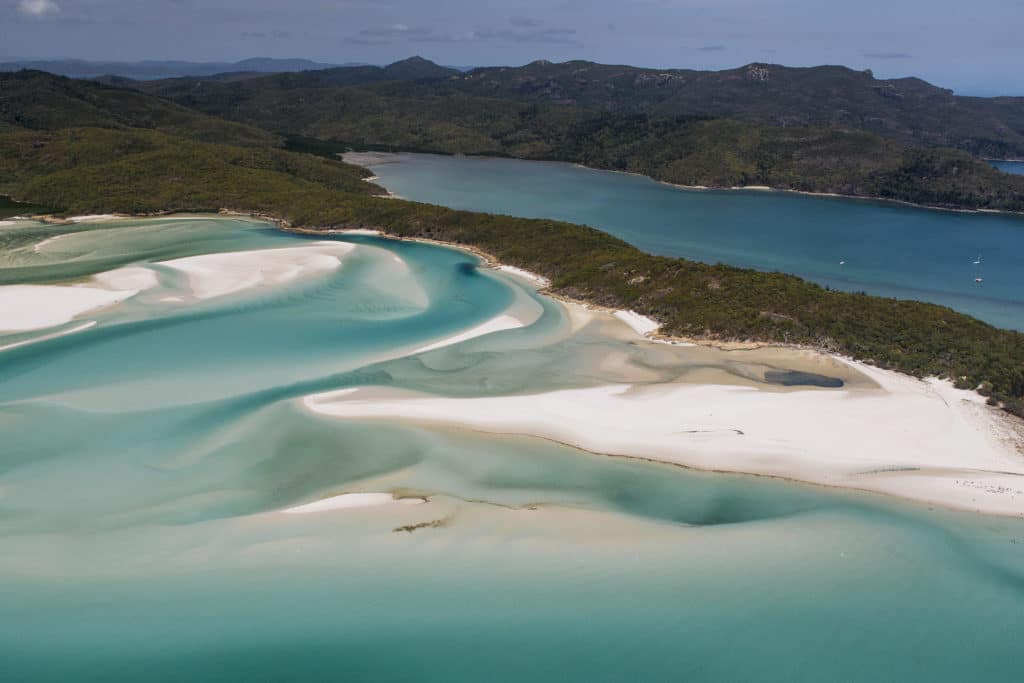
After we had dropped the hook and shut down the engine, Alisa and I looked at the colors of the anchorage and realized, “Ah, we’re back in the tropics!” The Whitsundays are the premier tropical sailing destination in Australia, and like so many famous places, they suffer from the crowded anchorages to which our Alaskan sensibilities have never adapted. But Haslewood wasn’t on the must-see list, and it gave us a break from the crowds. Throughout our 10-day stay, we shared the bay with only one other boat and a handful of green sea turtles.
Our camping experience in Alaska was mostly of the winter variety, so it was a treat to compare how Australians camped in the sand with our memories of camping in the snow. Miles gave us lessons in aboriginal uses of plants on the island, and we felt a tiny bit of understanding of Australian ecosystems begin to dribble into our brains. We all took turns snorkeling the reef and watching the kids on the beach.
The stop at Haslewood was a nice break from our friends’ hectic routine of working and child-rearing in Iluka. At first it seemed like a vacation for us, too, a nice break from our routine — none of my biology work that pays our way, no boat jobs, no work on my book about the trip from Alaska. But then I thought about it, and I realized that these 10 days weren’t really a break from our routine; this was the sort of routine that we try to get into, the purest sort of cruising. We had lots of leisure time each day, in a fairly wonderful spot, and we were doing it with local friends whom we never would have met if we hadn’t chucked it all to go sailing.
After we said goodbye to Miles and Melissa, we continued north to Townsville. Instead of the southeast trades that we might reasonably have expected, we found northwesterlies that made the few anchorages along the coast unusable and kept us tacking back and forth day and night. We passed a humpback whale cow and calf that breached and slapped the water with their pectoral fins. We passed flocks of pied imperial pigeons, striking black-and-white birds, flying over the water on their migration south from New Guinea. We made a trip inland to see a platypus in the wild.
Townsville itself was the completion of a grand circle for me, of course, but it was also a muted homecoming. I had no family still in Townsville, and no ties to the place. We set aside a month to stay there while I worked on my book every day. Alisa took advantage of the chance to get swimming lessons for Elias, and to enjoy the great playgrounds that are the heart of public places in Australia.
And during this time we began to answer some really big questions about our sailing future. A trip to the ultrasound lab gave us our first view of what we had long known to be the reason for Alisa’s recent vulnerability to seasickness: A new cabin boy would be signing on the following April.
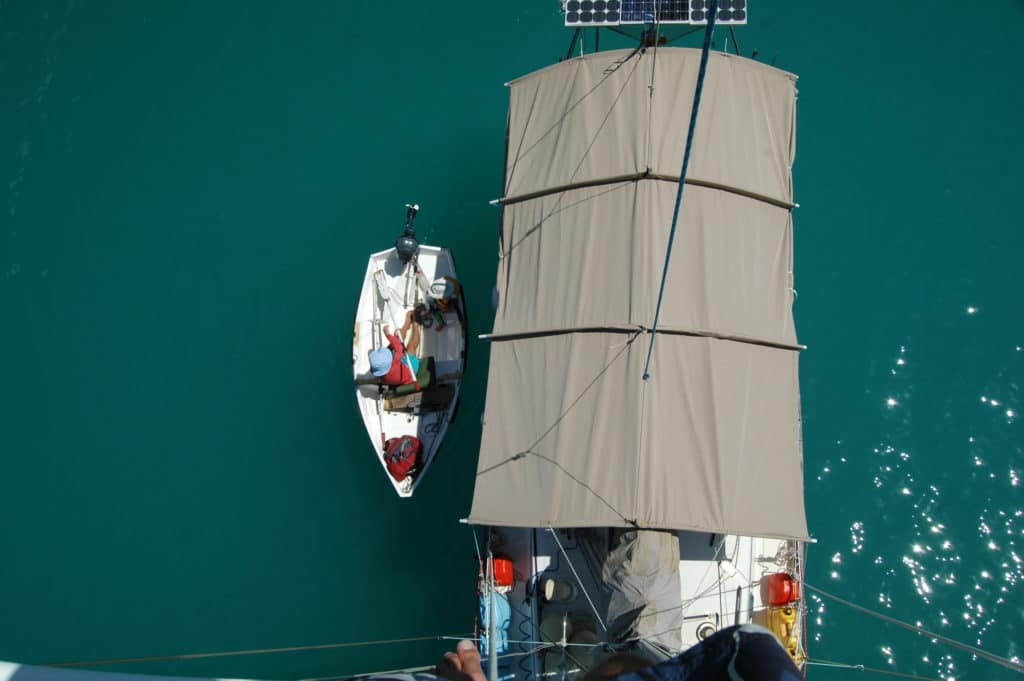
We needed to figure out how to handle this crew change. We wanted to stop somewhere in Australia for a year to let the new crew get to a certain age before we started traveling again. And we were rethinking the open-plan layout of dear old Pelagic for a family of four. We had years of sailing ahead of us, we hoped, and a kids cabin and an adult cabin seemed a good way to partition all the family togetherness that would entail. But where? Where would we park it for a year and contemplate that fearsome event, a boat swap?
People had often mentioned Hobart, Tasmania, as a jewel of Australia. I had been there only briefly 12 years before, and we knew no one there. More information would be welcome before we committed to a full year in the place. So when we found ourselves sharing the anchorage of Horseshoe Bay, on Magnetic Island, with Kukka, a smart-looking Malo 39 with Hobart as her hailing port, Alisa and Elias rowed over to say hello.
They came back an hour later with gold — a fresh stack of New Yorker magazines, unread by us, and news. Kukka, it turned out, belonged to Alex Nemeth and Diana Bagnall, and Hobart was merely a port of convenience; they were from Sydney. But Alisa had gone looking for news of Hobart and found something better: our people.
The crew of Kukka were on their first extended sail from home, with an eye toward longer trips in the future. Alex and Diana were both retired, he from being a pharmacist, she from journalism, and their children were young adults. Alisa and I were from the other side of the world, in the middle of our young-family years, with very different professional backgrounds. Yet we all hit it off immediately. Alex and Diana were two more good friends we never would have met if we hadn’t left home. Kukka was soon off to pick up a visiting son at the Townsville Airport. But they left us with a warm invitation to visit them whenever we might find ourselves in Sydney.
Summer was on its way back in, and with it the cyclone season. It was time to find our way south, and to sail our way into the answers to all those questions about the future.
We had been cavalier about the chance of getting caught with a long sail against the southeast trades while getting out of the tropics, since we had mostly found northwesterlies on our way up the coast. But — you can see where this is going — the trades reasserted themselves once we turned around and pointed the bow south. Day after day, we got up at 0400 and sailed all through the sunlit hours at a 30-degree angle of heel, tacking back and forth into the wind, dodging spray in the cockpit, and sopping up water on the cabin sole, and at the end of each day, we found we had made 30 miles.
Sailing to windward is uncomfortable enough for the nonpregnant, but Alisa was approaching that part of her pregnancy where everything is uncomfortable. And Elias was 3 by this time, and didn’t necessarily understand why he had to sit next to us in the sloping cockpit for hour after hour, reading the same books and singing the same songs, and why he never got to go ashore.
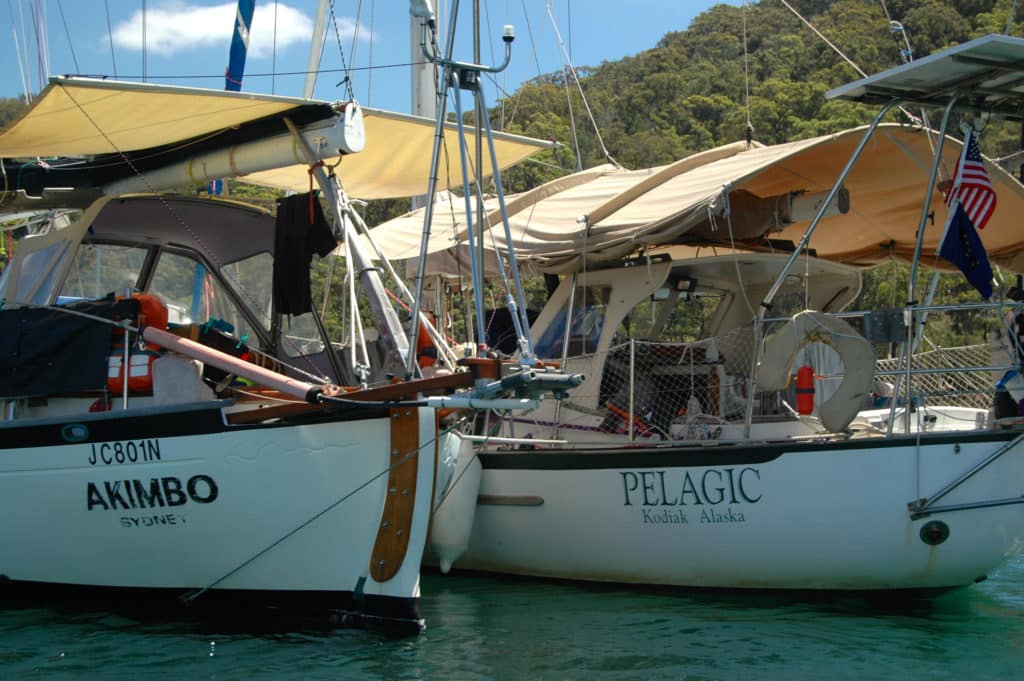
Eventually we did make it out of the southeast trades back to Iluka. And all too soon we were gathering with our friends there for a farewell barbecue at the beach. It was fun to think of settling down in Iluka long enough to have the baby, and we considered it. But the horizon still called; we weren’t ready to give up our wandering ways just yet. The draw of one more new place was too strong to resist, and Tasmania was in the offing.
Sydney was conveniently on our path down to Tasmania. Two weeks of sailing along an unfamiliar coast took us to Pittwater, the massive natural harbor just north of Sydney, where we caught up with our friends Peter Addenbrooke and Vanessa Georgeson on Akimbo, a well-kept double-ender that had carried them on years of adventures between Sydney and New Caledonia. They were some of our first Australian sailing friends. We had spent our first-ever Australian Christmas with them, and Peter had taken me for my first Australian surf. They now offered us the hospitality of a raft-up on their mooring in Pittwater, and the visit was perfectly timed for a second Australian Christmas in their company. We felt the beginnings of a tradition in this new country.
After a short sail down the coast, we had the pleasure of sailing into Sydney Harbour past the Opera House and under the Harbour Bridge. After San Francisco, this was the second great city of the world that we had sailed to on board Pelagic. Alex and Diana gave us more great hospitality, settling us into the visitors berth at the dock where they kept Kukka, handing us the keys to a car and their house, making us feel completely at home, and sharing the delights of the world-famous New Year’s fireworks in Sydney Harbour. Then, after another too-short visit, it was time for us to head farther south if we wanted to meet our goal of crossing Bass Strait before Alisa’s third trimester began.
Tasmania would be new to us, but it would be a novelty within a larger pattern that was familiar. After more than a year in Australia, we felt comfortable in the place. Part of being at home in Oz was the result of our physical knowledge of the continent — all the exploring that had seen Pelagic up and down the 1,100 miles of coastline between Townsville and Sydney. But our real feeling for the place, the things we treasured and the bits that still confused us, had come from a hundred interactions with Australian friends: the barbecues and surf sessions, the anchorages shared with sailors, and the great pleasure of taking nonsailing companions for a sail. Pelagic had turned into our magic carpet for discovering this new country, the vessel that had shown us the out-of-the-way anchorages and that had put us in the path of these new friends who filled us in on what it meant to be Australian.
Cruising, like any travel, really is all about the people.
After a stay in South Africa, Mike Litzow and his family are currently crossing the South Atlantic and headed, very slowly, toward home in Alaska. You can follow along with the family’s travels on their blog (thelife galactic.blogspot.com).








